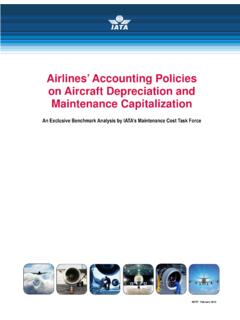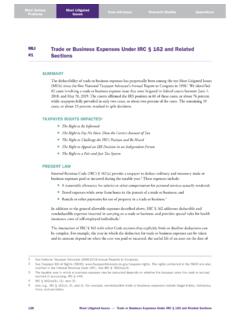Transcription of 26 CFR 1.179-5: Time and manner of making election ...
1 26 CFR : Time and manner of making election . (Also Part 1, 168, 446; (i)-4, ) Rev. Proc. 2019-08 SECTION 1. PURPOSE This revenue procedure provides guidance under 13101(b), 13204(a)(3), and 13205 of the Tax Cuts and Jobs Act, Pub. L. No. 115-97, 131 Stat. 2054 (Dec. 22, 2017) (the TCJA ). Section 13101(b) of the TCJA amended 179 of the Internal revenue Code by modifying the definition of qualified real property that may be eligible as 179 property under 179(d)(1). Section 13204(a)(3) of the TCJA amended 168 by (i) requiring certain property held by an electing real property trade or business, as defined in 163(j)(7)(B), to be depreciated under the alternative depreciation system in 168(g), and (ii) changing the recovery period under the alternative depreciation system from 40 to 30 years for residential rental property.
2 Section 13205 of the TCJA amended 168 by requiring certain property held by an electing farming business, as defined in 163(j)(7)(C), to be depreciated under the alternative depreciation system. This revenue procedure also modifies Rev. Proc. 87-57, 1987-2 687, to provide an optional depreciation table for residential rental property depreciated under the alternative depreciation system with a 30-year recovery period, and Rev. Proc. 2018-31, 2018-22 637, to provide guidance for calculating a 481(a) adjustment for a 2 change in method of accounting due to a change in the use of depreciable tangible property. SECTION 2. BACKGROUND .01 Modifications to 179. (1) Section 179(a) allows a taxpayer to elect to treat the cost (or a portion of the cost) of any 179 property as an expense for the taxable year in which the taxpayer places the property in service.
3 Sections 179(b)(1) and (2) prescribe a dollar limitation on the aggregate cost of 179 property that can be treated as an expense under 179(a). The dollar limitation is the amount under 179(b)(1) (the 179(b)(1) limitation), reduced (but not below zero) by the amount by which the cost of 179 property placed in service during the taxable year exceeds the amount under 179(b)(2) (the 179(b)(2) limitation). For taxable years beginning after 2017, the 179(b)(1) limitation is $1,000,000 and the 179(b)(2) limitation is $2,500,000. Pursuant to 179(b)(6), these limitation amounts are adjusted for inflation for taxable years beginning after 2018. For taxable years beginning in 2019, section of Rev. Proc. 2018-57, 2018-49 827, provides that the 179(b)(1) limitation is $1,020,000 and the 179(b)(2) limitation is $2,550,000.
4 (2) Section 179(b)(3)(A) provides that a taxpayer s 179 deduction for any taxable year, after application of the 179(b)(1) and (2) limitations, is limited to the taxpayer s taxable income for that taxable year that is derived from the taxpayer s active conduct of any trade or business during that taxable year (taxable income limitation). Section 179(b)(3)(B) provides that the amount of any cost of 179 property elected to be expensed in a taxable year that is disallowed as a 179 deduction under the taxable 3 income limitation may be carried forward for an unlimited number of years and may be deducted under 179(a) in a future year, subject to the same limitations. (3) Section 179(c) provides the rules for making and revoking elections under 179 ( 179 election ).
5 Pursuant to 179(c)(1), a 179 election is made in the manner prescribed by regulations. Section (c)(1) of the Income Tax Regulations provides the manner for making or revoking a 179 election for any taxable year beginning after 2002 and before 2008. Section (c) was promulgated in 2005 and has not been amended to reflect subsequent amendments to 179(c). However, in 2017, the Treasury Department and the IRS issued Rev. Proc. 2017-33, 2017-19 1236. Section of Rev. Proc. 2017-33 provides that for a taxable year beginning after 2014, the taxpayer will be permitted to make a 179 election for any 179 property without the Commissioner s consent on an amended federal tax return for the taxable year in which the taxpayer places in service the 179 property.
6 Section of Rev. Proc. 2017-33 further provides that until (c) is amended to incorporate this guidance, taxpayers may rely on such guidance. (4) Section 179(d) defines the term 179 property. Prior to amendment by the TCJA, 179(d)(1) defined 179 property as property that is: (A)(i) tangible property to which 168 applies, or (ii) computer software, as defined in 197(e)(3)(B), that is described in 197(e)(3)(A)(i) and to which 167 applies; (B) 1245 property as defined in 1245(a)(3); and (C) acquired by purchase for use in the active conduct of a trade or business. Prior to amendment by the TCJA, 179(d)(1) further provided that 179 property does not include any property described in 50(b).
7 4 Section 13101(b)(1) of the TCJA amended 179(d)(1)(B) to provide that if the taxpayer elects, 179 property may include qualified real property as defined in 179(f). Section 13101(c) of the TCJA also amended the flush language in 179(d)(1) to allow property used predominantly to furnish lodging or in connection with the furnishing of lodging as described in 50(b)(2) to be 179 property. These amendments apply to property placed in service in taxable years beginning after December 31, 2017. (5) Prior to amendment by the TCJA, 179(f)(1) provided that 179 property included qualified real property if the taxpayer elected the application of 179(f) for the taxable year, and 179(f)(2) defined qualified real property as meaning qualified leasehold improvement property, qualified restaurant property, and qualified retail improvement property described in 168(e)(6), (7), and (8), respectively, as in effect on the day before the date of the enactment of the TCJA.
8 Section 13101(b)(2) of the TCJA amended 179(f) by defining qualified real property as (1) any qualified improvement property described in 168(e)(6) and (2) any of the following improvements to nonresidential real property placed in service after the date such property was first placed in service: roofs; heating, ventilation, and air-conditioning property; fire protection and alarm systems; and security systems. These amendments apply to property placed in service in taxable years beginning after December 31, 2017. Some taxpayers have inquired as to whether the election to treat qualified real property as 179 property is made in accordance with the 179 election procedures in (c) or the procedures in Notice 2013-59, 2013-40 297, for electing the 5 application of former 179(f)(1).
9 Section 3 of this revenue procedure addresses this issue. (6) Section 401(b)(15)(A) of the Consolidated Appropriations Act, 2018, Pub. L. No. 115-141, Div. U, Title IV, 132 Stat. 348 (Mar. 23, 2018) (the 2018 Act ), removed 179(e), which provided special rules for qualified disaster assistance property, and redesignated 179(f) as 179(e)..02 Modifications to 168(g). (1) Prior to amendment by the TCJA, 168(g)(1) provided that the depreciation deduction provided by 167(a) is determined under the alternative depreciation system for: (A) any tangible property that during the taxable year is used predominantly outside the United States; (B) any tax-exempt use property; (C) any tax-exempt bond financed property; (D) any imported property covered by an Executive order under 168(g)(6); and (E) any property to which an election under 168(g)(7) applies.
10 Sections 13204(a)(3)(A)(i) and 13205(a) of the TCJA amended 168(g)(1) by requiring the depreciation deduction provided by 167(a) to be determined under the alternative depreciation system for the following additional property: nonresidential real property, residential rental property, and qualified improvement property held by an electing real property trade or business as defined in 163(j)(7)(B); and any property with a recovery period of 10 years or more that is held by an electing farming business as defined in 163(j)(7)(C). These amendments apply to taxable years beginning after December 31, 2017, without regard to when the property is or was placed in service. Some taxpayers that are electing real property trades or businesses or electing farming businesses have inquired about how depreciation is changed from the general 6 depreciation system under 168(a) to the alternative depreciation system under 168(g) for property placed in service in taxable years beginning before 2018.














